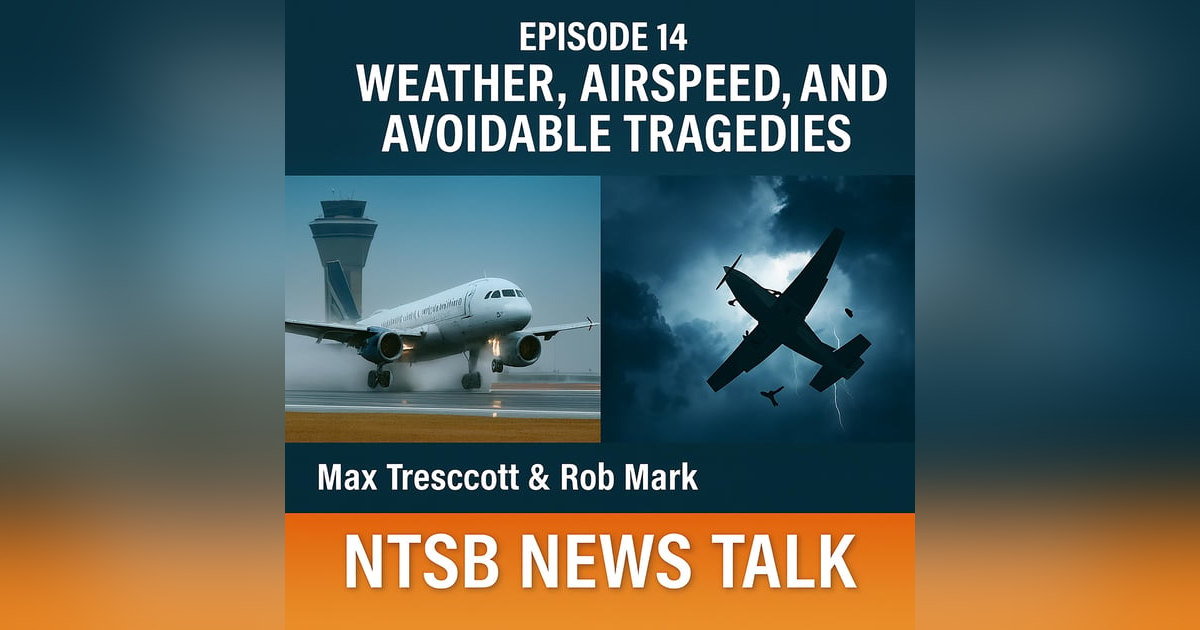Weather, Airspeed, and Avoidable Tragedies: NTSB Lessons from LAX to Lake Placid

In Episode 14 of NTSB News Talk, hosts Max Trescott and Rob Mark analyze a series of recent NTSB preliminary and final reports that reveal how weather, fatigue, distraction, and airspeed management continue to play major roles in both near misses and fatal crashes. With their characteristic mix of insight and practicality, the two veteran aviation journalists connect the dots between accidents that could have been avoided — from runway confusion at LAX to a tragic Cessna 210 in-flight breakup in a thunderstorm.
The episode begins with a dramatic runway incursion at Los Angeles International Airport. An American Airlines A320 was forced to abort its takeoff at 145 knots when a Boeing 777 cargo jet accidentally turned onto the same runway. The controller, distracted and calling the wrong call sign several times, urged the cargo flight to “cross quickly,” which only compounded the confusion. Thanks to a quick-reacting Airbus crew and reliable communications on LiveATC.net, disaster was narrowly avoided. Rob and Max explain that high-speed rejected takeoffs are among the most dangerous maneuvers in aviation because they push brakes, thrust reversers, and pilot reflexes to their limits. They emphasize that even in this case — where no one was injured — such events underline how fatigue, communication errors, and poor situational awareness can converge in seconds at busy airports like LAX.
From there, the hosts shift to a string of recent fatal general aviation crashes, all with different aircraft and weather profiles but a common theme: loss of control in challenging conditions.
The first involved a TBM 700, N111RF, that crashed shortly after takeoff from New Bedford, Massachusetts, during poor weather associated with a nor’easter. The aircraft struck a car on Interstate 95, killing both people onboard. ADS-B data showed the plane leveled off at just 800 feet and remained below the cloud layer before descending out of control — possibly an example of a pilot hesitating to enter IMC, losing situational awareness in marginal VFR.
Next, they discuss a Beech Baron, N121GJ that went down near Williston, Florida. Three people were killed when the twin appeared to descend rapidly — over 3,500 feet per minute — just as thunderstorms moved through the area. With lightning reported nearby, the NTSB suspects weather penetration or turbulence led to the loss of control.
A third case, a Beechcraft King Air C90, N291CC, that crashed near Hicks Airfield in Texas, drew particular attention because it appeared to be a training flight. The aircraft had spent 90 minutes practicing approaches before a sudden, steep, left-turn descent at low altitude. ADS-B data showed the aircraft slowed below 100 knots, consistent with an aerodynamic stall, possibly during simulated engine-out training. Both pilots were killed. Max and Rob discuss how multi-engine training carries inherent risk, especially when one engine is feathered or throttled back. “Airspeed is life,” they repeat — a theme echoed throughout the episode.
In two preliminary reports, Max walks through additional lessons for pilots. A Sport Cruiser, N336SC, in Maine experienced an apparent engine failure, with witnesses reporting a loud pop before seeing the aircraft descending with its parachute only partially deployed. The host notes that parachute systems like CAPS are highly effective when deployed early, but once below 1,000 feet, the odds of survival drop sharply. Another case involved a Cessna 340, N269WT, departing Houston’s David Wayne Hooks Airport. After takeoff, the pilot requested to return but stalled and crashed on final approach with the gear down and flaps retracted. The NTSB found no mechanical issues. Both hosts speculate that an unnecessary return — possibly for a door warning or minor issue — can turn deadly if pilots lose focus on maintaining airspeed.
The most widely discussed final report revisited the Lake Placid crash that killed AOPA Air Safety Institute’s Richard McSpadden and former NFL player Russ Francis. The Cardinal RG suffered a partial power loss after takeoff and attempted a turn back to the runway, but stalled and crashed. The NTSB cited loss of control and improper weight and balance planning. The case reignited the ongoing debate about the so-called “impossible turn.” Max and Rob strongly caution pilots never to attempt a 180-degree turn back to the airport after engine failure unless altitude, training, and aircraft performance clearly allow it. They note that even AOPA’s follow-up video subtly softened its earlier message, changing “turning back is a viable option” to “may be a viable option.”
Later in the show, the hosts analyze an NTSB report from San Diego where a Citation 560XL, N564HV, nearly landed atop a Southwest 737 after distracted controllers forgot the landing clearance. Only the airport’s ASDE-X ground radar system — which alerted both tower and crew — prevented a catastrophe. Max points out that fewer than 75 airports in the U.S. currently have ASDE-X, though the FAA is now deploying ASDE-X Lite, a more affordable ADS-B–based version that will bring runway-incursion protection to smaller airports.
The final case involves a Cessna P210, N210JT, that broke up in flight after the pilot flew directly into a severe thunderstorm while descending toward Thomaston, Georgia. Despite having onboard radar and a lightning detector, the pilot never requested or received a weather briefing. The NTSB concluded that the pilot’s failure to avoid convective weather was the primary cause. Max compares it to the 2006 Scott Crossfield accident, another 210 that entered a thunderstorm with fatal results. Both hosts urge pilots to remember that NEXRAD radar is delayed by up to 10 minutes and that even a brief lapse in judgment near convective activity can be catastrophic.
Throughout Episode 14, the recurring themes are unmistakable: weather awareness, disciplined airspeed control, fatigue management, and pre-planning. Whether it’s a cargo 777 taxiing into harm’s way at LAX or a single-engine pilot attempting a low-altitude turnback, most of these tragedies share a common trait — they were preventable. As Max concludes, “Airspeed is life." And so is thinking ahead.